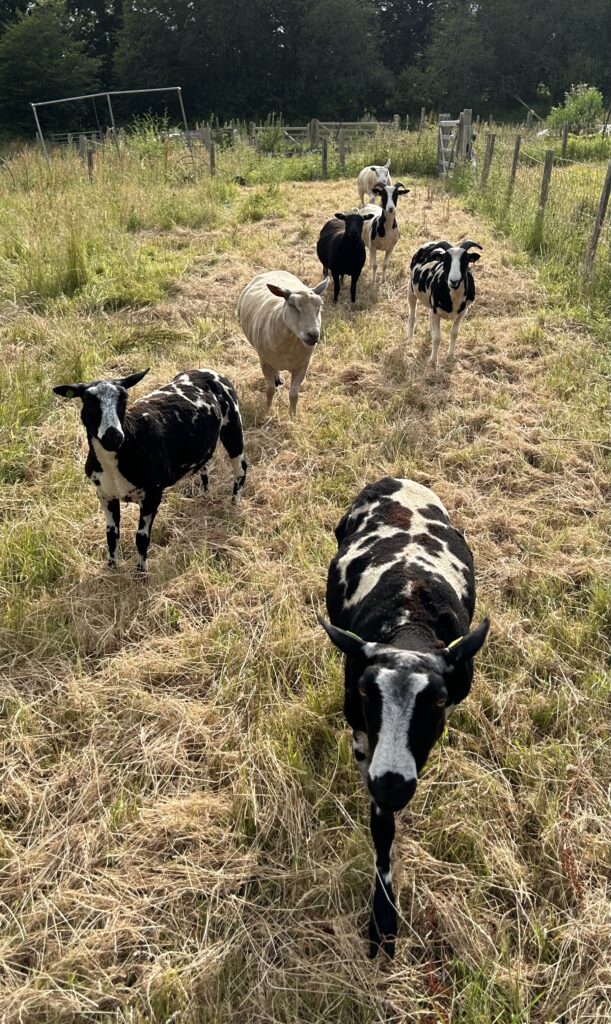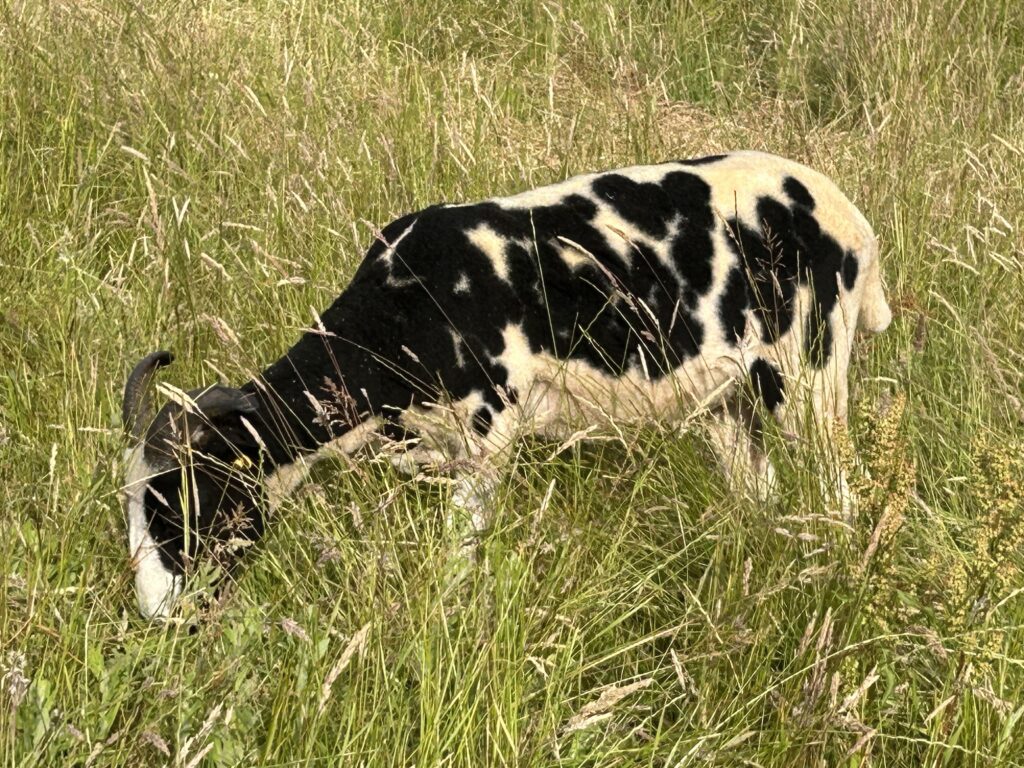
It’s obviously better to prevent disease than to try and treat it, so first and foremost I keep the animals as healthy as I can. This comes in a few guises; firstly, the soil biome is a mini ecosystem and so needs to be kept balanced, healthy and full of lifeforce/vitality, if we have healthy soil, we have healthy pasture, healthy animals and so on…it also contributes to our ethos of holistic farming with herbalism.
We look after our pasture without the use of fertilisers, or even ‘spreading manure’, but by rotational grazing, which requires a three month rest after each grazing. It also gets fertilised naturally by sheep poo. We hope to add cows next year as they are the absolute best at fertilising. Have you seen the size of a cow pat?! The dung beetles do a fantastic job of pulling the nutrients down into the soil (some up to 2 metres), and all other bugs and worms become very happy, ingesting, digesting and secreting more nutrients.
The ‘golden hoof’ of the sheep being light also pads the soil down, ironing where there may be too many holes and pushing any dead thatch back in, which adds nutrients as well as carbon, a bit like a compost. Cows do an even better job pushing thatch back down as they are heavy, so push it a little deeper, and make holes with their feet where water can pool feeding wildlife and insects. However, you must be careful not to poach the land too, as if you break the root system, the grass has to use energy to grow back. Cows also pull the grass out in clumps while grazing, bringing in light and making space, while sheep cut the tops giving it a trim, and this diversity of action by animals and insects creates a balanced ‘diet’ for the soil and pasture too, helping it to become a rich diverse ‘diet’ for anything foraging on it.
Grasses and Grazing
Keeping a diverse mix of grasses and herbs in your pasture is important too, as different root actions – deep, shallow, spread out, etc – helps the soil adapt. The land itself will often encourage the weed/plant that it needs for nourishment, or for fixing structure etc. For example, when you have impacted soil, the land will encourage the growth of dock and/or nettle for instance, as docks have big deep roots and the nettle roots have mass. All this helps break up the soil balancing compaction, and bringing in air and nutrients which the mini soil ecosystem needs to flourish.
Using rotational grazing ensures that the sheep and chickens get clean, healthy new pasture. This means that they are less likely to eat worms left on pasture that they have grazed; a common symptom of set stocking, where animals are grazed in one large area for a long period of time. Sheep eating slightly longer grass also helps with this. Rest periods give the pasture time to recover and also the parasitic worms to start to die off. (We always want the good worms, it’s just the parasitic worms we don’t want!).
All animals seem to know how to naturally self-select, so if your pasture contains a diverse set of different plants and herbs, they will naturally select what it is they need to keep their bodies healthy. This is why when you let any animal out of a field, it will automatically gravitate to the hedges to self-administer the herbs and plants it needs. This is also why it is good to have full naturally grown diverse species hedges in fields too. So keeping them well with a balanced, healthy, herbal diet is key which is one of the reasons why we take the approach of holistic farming with herbs.
Herbal Treatment of Sheep

We got our first sheep three years ago, Bella a Texel and Smarty Pants a Charolaise, both were lambs. Coming from a conventional system, they had been chemically treated for worms, (quite harsh ones as most are). Many conventional farmers continue to do this, causing immune systems to be weaker, pastures to be poor (remember chemicals in the poo is then fed to the precious dung beetles, worms and other ecosystem warriors, who are then poisoned as a result, so they can’t do their job of feeding your pasture, which means unhealthy pastures being fed back to your animals).
Instead, we use a our approach to holistic farming with herbs concentrates on preventative measures, and then using herbs to support the immune system. Many people think we are mad, as sheep can die very easily if not treated promptly. To counteract the risks, we stay small, so we can monitor regularly. We do Faecal Egg Counts to count worms in their poo, before and after treatment; many farmers do this, and if the count is over 400, they will treat with chemicals. This is a better system than that of some years ago when farmers treated for worms every three months regardless. This was obviously very bad, killing the eco-life in the soils, so producing less nutritious fodder and less healthy animals with weak immune systems. As a result, many farmers now also have resistance to the chemicals on their farms, and so increased chemicals are needed and the cycle continues towards a bleak future.
When Bella and Smartypants arrived, their faecal egg count was around 2000 for both coccidiosis and strongyle worms. After the treatment below, the coccidiosis went right down to below 50 (this has happened a few times now, so I am getting more confident that this works). It does reduce the Strongyle Worms, but doesn’t irradiate or reduce as much. Bearing in mind some worms left behind after treatment is always good for helping to build immunity. I treat five days before the full moon with just garlic, molasses and cider vinegar, and then on the full moon and five days afterwards with the wormwood concoction below. I didn’t need to treat them again for two years.
We got four new lambs last year, bought in from a conventional system; again, two Jacobs and two Dutch spotted, so we have a funny colourful flock now. They too came with a high infestation of worms. I repeated the same process, but it took three moons of the same treatment for it to work. I did get a bit worried after the first two treatments, and even asked a neighbour for an emergency dose of chemical wormer, (due to the horror stories I have been told about sheep dropping dead). It felt risky to continue, but the sheep all remained looking well with no clinical signs, so I used the herbal wormer one more time. The count after this was about 400; some would worm again at this count, but I felt that they were looking very well, perfectly formed manure with etc, and I let them continue to build immunity. I did a further count around three months later and all the worms in all the sheep were down to below 50, or below 100, so the sheep have managed to reduce the worm count themselves over these last three months. This is despite many farmers warning that worms are high currently due to the warm wet weather we are having.
Deworming Sheep
5 consecutive days before the full moon:
I am NOT a medical herbalist, so have not passed this concoction onto anyone, but I used the recipe that we made on your foundation course for human beings/children’s worms and adapted somewhat for ease of administration, by reading Juliette de Bairacli Levy, and quite a few other bits and pieces of information gathered from elsewhere.
Methods:
- 1 tablespoon garlic powder 1x tbsp molasses per sheep
- Mix in Pyrex jug
- Add 1/4 hot water and 3/4 cider vinegar (with mother) mix formula until liquid
- Put in a syringe
> Lamb 20ml
> Ewe 40ml
> Ram 60mg
- Squirt in mouth
- Feed them after with a few nuts/ carrots, pumpkin seeds and coconut
Treatment on full moon and 5 days afterwards:
- Wormwood 1 teaspoon
- Valerian 1 teaspoon
- Star anise x 1
- Cloves x 5
- Nettle, Cleavers, Peppermint, Rosemary, marshmallow ½ handful
- 2 cups boiling water and stand until the water is dark – overnight
- Mix with the leftover garlic/molasses/cider vinegar mix (or make a bit more but no more than a ½ of this as it waters down your herbs
- Black walnut (Haven’t used it yet but its in lots of other recommendations)
> Lamb 20ml
> Ewe 40ml
> Ram 60mg
- Squirt in mouth
- Feed them after with a few nuts/ carrots, pumpkin seeds and coconut
Alternative Therapies for Foot Rot in Sheep
I recently had four sheep: Bella, Maud, Treacle and Smartypants, with foot rot in one foot each. Many conventional farmers will use a formaldehyde-based foot bath, which the sheep hate (as its acid), and the farmers hate as it is very dangerous and bad for everyone’s health. However, it is convenient if you have many sheep as it hardens the hoof, not something I would dream of using. Some use antibiotic spray. I managed to completely eradicate the foot rot with natural methods. I gave all the sheep a warm Epsom salts foot bath with tea tree and citronella oil. This was to draw out bacteria (Epsom Salts) and kill it (tea tree and citronella). The sheep were happy to stand for a while in it, unlike the frantic jumping I have seen trying to get out of the acid foot bath, which incidentally causes stress and stressed animals tend to get sicker and have reduced immunity, so it can cause a downward slope.
On the lame sheep, I followed the bath by making a sugar solution with iodine, or tea tree and citronella. I stuffed this in-between the toes of the infected foot, put cotton wool on top, vet wrap (bandage) and gaffa tape, to keep the water out. I had to keep the sheep in dry ground too, as the Foot rot/bacteria lives in the wet. The sugar dries everything right up so that the bacteria can no longer survive, it hardened the hoof completely and the rot didn’t come back.
Treating Flystrike Disease with Herbs
Flystrike is another issue with warm weather. I haven’t had a case yet, but farmers hate it as the flies lay eggs under the sheep’s wool, and when the maggots hatch, they eat the sheep’s flesh, it sounds pretty gruesome and sheep have been known to die of this. Farmers and sheep find it very distressing as you don’t see it until it has taken hold. Many farmers will use a harsh chemical that penetrates the skin and so prevents flies and flystrike. Again, it’s not good for the animal, and can cause stress for farmers and animals. Due to it going inside the skin of the animal, they can’t sell lambs without a withdrawal time as this chemical goes into the meat.
So far, I have used a concoction of Neem oil, Coconut oil (as that makes it stiff and stick to the wool for longer), Tea Tree oil, Citronella and Eucalyptus, In fact, I tend to use that for a few things, such as wounds etc. I rub it all over their bellies, armpits and pour some on their backs and tails, so they do smell a little neem oil, rather than like sheep, but it seems to work.
Last year, Smarty Pants also had a red patch on her chest, which looked a bit like sheep scab. I used this, and after a few days it healed up. So far, I haven’t had to have any conventional or chemical treatment, nor vets; the chemicals are very high cost in comparison to herbs and essential oils, so it’s definitely worth it.

